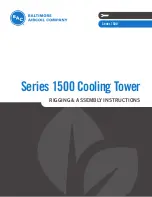
Page 24
6.
Set the refrigerant container onto an electronic
charging scale, and record the weight (or zero-out
the scale, depending on the scale used).
7.
Start all indoor units attached to the system in
cooling mode, and lower the set points on each of
their controllers to the minimum setting, so that the
system will not shut off during the procedure.
8.
Refrigerant can now be added to the system.
Open the lower side manifold valve at the lower side
of the gauge manifold, and get set to start charging
the unit with liquid refrigerant. Please remember to
nurse the refrigerant in slowly by controlling the
lower side manifold valve at the lower side of your
gauge manifold (open for 3 seconds and close for
10 seconds for the system to digest each load).
Keep track of the refrigerant being added into
the system (do not overcharge the system).
9.
Once the correct charge has been added to
the system, close the lower side gauge valve at the
lower side of the gauge manifold set, and check
the operating pressure. Keep running the system
continuously for 20 minutes, and record the
pressure reading, along with the indoor and
outdoor temperature readings for future reference.
The system is now charged and can be shut off.
10.
Close the valve on the refrigerant container
and disconnect the hose from the manifold set.
Also, disconnect the hose from the 3-way (gas)
valve where it is attached to the unit, and replace
and torque all brass dust caps.
Be sure to use a torque wrench to tighten the
service port caps to a torque of 18N·m (13.3 ft·lbs).
Always leak-check all service ports after servicing
the refrigerant system.
ADDING OR REPLACING REFRIGERANT AFTER
A REFRIGERANT LOSS IS DISCOVERED:
Please note: R410a is a blended and isotropic refrigerant.
If refrigerant is lost from your system in significant
amounts (exceeding 15% of the total volume), the
remaining refrigerant may no longer contain the proper
original ratio of the blend. Therefore, the system must be
entirely evacuated and recharged with fresh refrigerant.
If the system is determined to have lost only a small
amount of refrigerant, it can be topped off using the
same procedure as covered above, until proper operating
pressures and performance are obtained. Prior to
recharging refrigerant after a leak is discovered, the leak
itself must be located and repaired to avoid repeated
refrigerant losses. A well-sealed system will never need
refrigerant to be recharged, as it stays as a sealed-closed
system entirely.
COMPLETE PROCEDURES EXPLAINING THE METHODS
FOR COMPLETE EVACUATION AND FRESH REFRIGERANT
RECHARGE ARE EXPLAINED IN THE SERVICE MANUAL.
PLEASE REFER TO THE ENGINEERING AND SERVICE
MANUAL WHICH CAN BE DOWNLOADED ONLINE
AT THE MANUFACTURER’S WEB SITE.
Outside Diameter
Torque
Additional Tightening Torque
mm
inch
N.cm
N.cm
Ф6.35
1/4
1500 (11 LbF*Ft)
1600 (12 LbF*Ft)
Ф9.52
3/8
2500 (18 LbF*Ft)
2600 (19LbF*Ft)
Ф12.7
1/2
3500 (26 LbF*Ft)
3600 (27 LbF*Ft)
Unit
AWG
DUAL (2 Zone)
14
TRIPLE (3 Zone)
14
QUAD (4 Zone)
12
QUINT (5 Zone)
10
Flare Nut Torque Values:
Main Power Input Wiring Gauges:
For 4-lead interconnecting cables, use AWG-16
wiring for any capacity or type indoor unit. If
preferred, a suitable Romex 14-3 can also be used.
WARNING FOR 3, 4, 5-ZONE:
COMMON (MASTER) VALVES
MUST BE OPENED BEFORE
OPENING THE CIRCUIT
SERVICE VALVES. RUNNING
THE SYSTEM WHILE THE
MASTER VALVE SET IS CLOSED
WILL RESULT IN INSTANT
COMPRESSOR FAILURE !






































